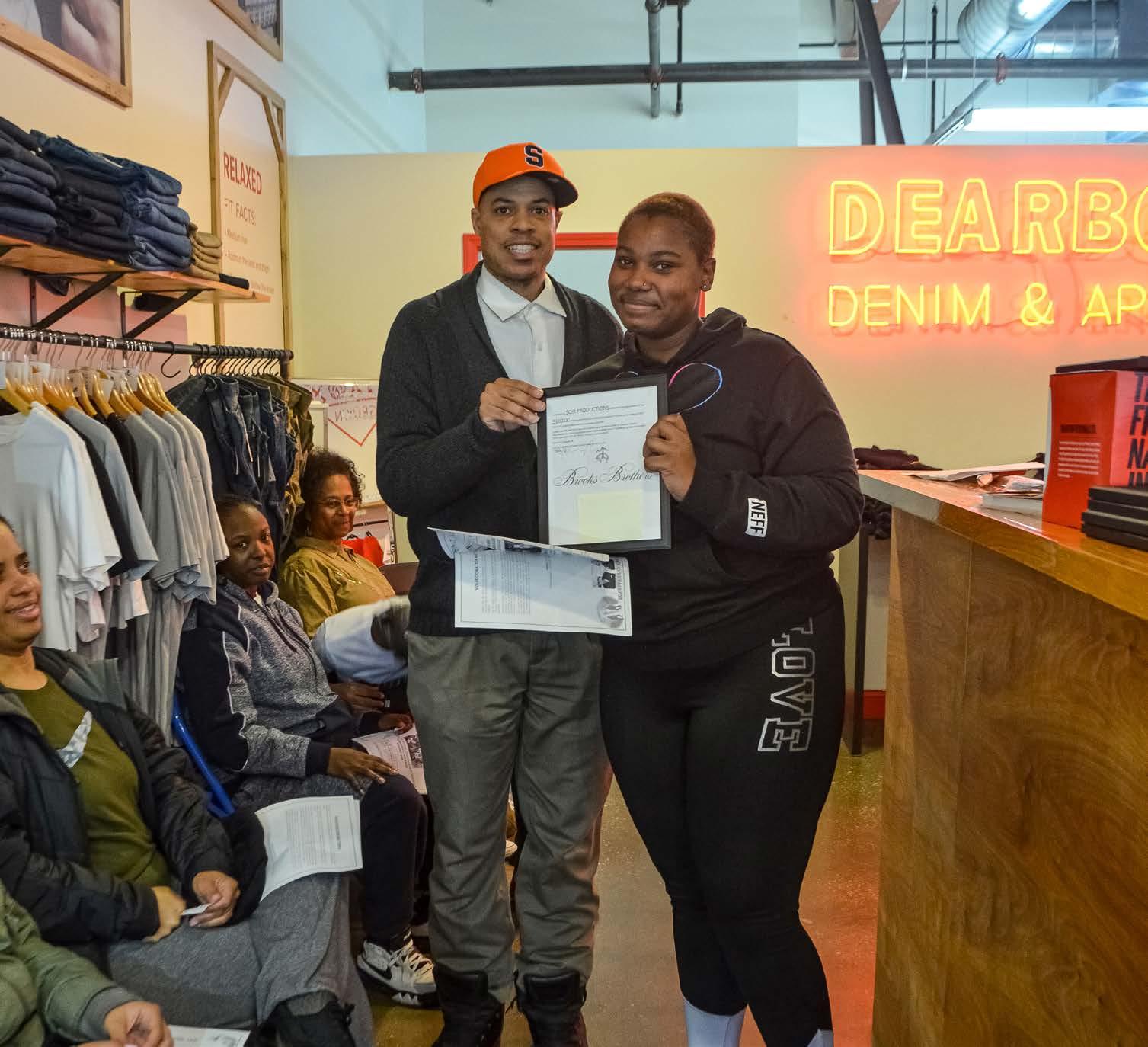
10 minute read
modeling for success
PAULA FRIEDRICH AND BILL HEALY
BRIDGET VAUGHN
Advertisement
A fashion runway program empowers students to pursue their dreams
In the summer of 2018, my friend Lovetta Spencer invited me to attend a fashion show at Dearborn Denim and Apparel in Hyde Park. Her son Zion, a recent graduate of South Shore International High School, had been selected to receive a scholarship at the fashion show. And there, I met Stanley Coleman Jr.
A native Hyde Parker, Coleman graduated from Kenwood High School and has a business degree in management and broadcast journalism from Columbia College. After graduation, he worked for the Chicago Sky, and then in South Shore politics. A former teacher and program
BY BRIDGET VAUGHN
coordinator at South Shore International High School, he founded SCJR Productions two years ago as a way to help high school students learn something new, engage with others out of school, and receive financial assistance toward college
“As future leaders of tomorrow, we encourage our students to become proactive in seeking solutions in the face of adversity,” Coleman writes on the SCJR website. “With out-of-town tuition costs and college loan interest rates skyrocketing, even the smallest contribution toward a student's college expenses helps with necessities such as boarding, books, and school supplies.” SCJR’s popular Fashion/Modeling 101 program was created in response to an afterschool activity survey, which showed that students wanted activities that fostered courage, confidence, and self-esteem and helped them reach their dreams in college and beyond. Coleman secures scholarship support for his troupe by tapping into his network for donations and seeking out organizations that support his mission. The financial assistance helps motivate students to do well in school as well as on the runway. At the October 2019 fashion show, two students received $1,250 in scholarships. In an earlier show, one student received combined scholarships totaling more than $5,000.
In the past two years, Coleman has given out close to forty scholarships and over one hundred students have participated in the runway program. He treats the models with respect and takes pride in their choices. The students learn life skills, including poise, confidence, the business side of fashion, being responsible on social media, booking shows, and how to safely navigate the fashion world. Students will have these skills for the rest of their lives, whether or not they end up pursuing careers in fashion.
Coleman lives a few blocks from the
Silver Room, on 53rd Street in Hyde Park. When, in 2017, Dearborn Denim opened next door to the neighborhood anchor, Coleman reached out to see if general manager Kaleb Sullivan would be interested in hosting a regular fashion show. Sullivan, said Coleman, was keen to give back to the community and its youth.
The December fashion show was SCJR Productions’ eighth event at Dearborn Denim and Apparel. The store, with hardwood floors and neon signs, sells men’s and women’s jeans, shirts, hats, belts, and other casual attire in a long and relatively narrow space. The setting was perfect for a fashion show where students modelled denim and streetwear. Chairs for sixty guests were placed in rows along the walls.
While the models changed clothes between acts, Coleman engaged the audience with raffle prizes, announcements, the presentation of student scholarships, and performances.
At the October show, CBS 2 reporter Suzanne LeMignot acknowledged the attendees, the models, and announced raffle ticket winners. During intermission, local rapper and spoken word artist and Dearborn Denim staffer June performed several of her original songs.
Since the program began, the modeling troupe has performed at the Black Women’s Expo and been featured on local media.
“I like this program because of the experience and the people that I meet throughout the program,” said one student, a junior. “This program is helping me be more professional. After this, I want to go to college to do graphic design, engineering and photography.”
While Coleman teaches the modeling classes, he also relies on some of his more experienced students, typically juniors and seniors. They have their boots on the ground and circle back to Coleman with suggestions and concerns related to the upcoming shows. He encourages them to be comfortable coming to him with ideas or simply to talk about life.
The students intentionally model fashionably cool, casual streetwear and clothing that is unapologetically Black. Coleman wants his models to represent Black heritage and community with intention.
“It’s really nice to model with my classmates. Just to see them make themselves so beautiful and confident,” said one student, a senior who is planning on attending the University of Illinois and majoring in business. “The reason why I model now is to build a platform for myself so Black women can know they are beautiful, to demonstrate that they can be beautiful on the magazine covers just like the European women are cast.”
The troupe also uses the runway to promote various causes and platforms, including #TimesUp, #MeToo, breast cancer awareness, lupus awareness, and pediatric cancer awareness. “We are not just a typical runway program,” said Coleman. “We want to be that kind of program that services the needs that are the immediate of our community.” SCJR Productions is a family effort. Coleman’s mother, brother, and stepfather attend and help out at the fashion shows and support the work he’s doing. “My mom, my stepdad, and my younger brother, they’ve been amazing. I couldn’t do what I am doing without those three,” said Coleman.
When the modeling program began in 2017, most of the models came from South Shore International High School. Now, models from other high schools participate as well, including students from Kenwood Academy, Jones College Prep, Glenbard South, Martin Luther King High School, and charter schools. As word continues to get around about the program, Coleman feels confident that he’s on track to dominate this market and to continue adding new scholarships for the student models to help alleviate the cost of college.
Bridget Vaughn is a contributor to the Weekly. She last photographed and wrote for the Weekly about eight houses of worshop during the 2018 Open House Chicago. ¬
BRIDGET VAUGHN


BRIDGET VAUGHN
Get involved today.

The South Side Weekly is a volunteer-run nonprofit newspaper written for and about the South Side of Chicago.
Submit a tip @ sswk.ly/tip



Attend a workshop @ sswk.ly/workshop

Become a contributor @ sswk.ly/contribute
Established as a way to ensure parent and staff input into the running of schools, Chicago’s Local School Councils were heralded as a potent mechanism to empower communities.
Twenty years later, many councils suffer from vacancies, parent indifference, and a sense of powerlessness. But with council elections looming in April, the school district is hoping to beef up participation, parents are speaking out, and a key state bill could boost the councils’ profile. Chicago community groups are seeking to engage parents and community members and press lawmakers to give the bodies more teeth.
In a city lacking an elected school board, “It is the only democracy we have within the education system in Chicago,” said Rod Wilson, an organizer from the Lugenia Burns Hope Center, at a workshop aimed at strengthening the councils.
“If you’re getting public dollars then we’re saying that parents should have some say in the governance of the school.” But some parents feel as if they’re fighting an uphill battle to create change.
“Most members don’t welcome me there,” said Myriam Perez, who has served three terms as a community representative on the council of her former school, Nathan S. Davis Elementary in Brighton Park. She joined the council because she wanted to give back to the school that made her feel safe when she didn’t in her own home. But she’s had a mixed experience.
“I tend to ask a lot of questions, I MARIE FAZIO

tend to call people out if they’re not doing something … I don’t like going sometimes but I go anyways because I know that I want to speak up for students that might want a safe space at Davis.”
At the Saturday workshop, the host group Raise Your Hand encouraged attendees to get involved with their councils and briefed on coming changes, including the proposed LSC Empowerment Bill that would bolster councils’ powers.
More than 150 council members, parents, teachers and community members, plus several school board members, attended the Saturday workshop at offices of the teachers union.
Chicago is the only city in the state that uses the local school council model in public schools. Each school council has space for six parents, two teachers, one non-teacher staff member and two community members, as well as a student representative in high schools.
The councils have the authority to hire and evaluate the principal, allocate discretionary funds, and approve and monitor the school improvement plan.
Charter schools, contract schools and military schools—which together make up about one-fifth of public schools in the city—do not have councils.
But those schools would be required to form local councils under a state bill proposed by state Representative Sonya Harper, of the 6th district, and state Senator Ram Villivalam, of the 8th district. The bill
Wanted: Ways to boost the profile of Local School Councils A new state bill could be a start
MARIE FAZIO, CHALKBEAT CHICAGO
also would allow councils to keep decisionmaking authority when schools are on probation.
It also would prohibit the district from closing any school without a supermajority of the council approving.
Additionally, the bill would scale back district influence on the councils and create advisory positions for seventh and eighth graders. In response to criticism about the preparation and ongoing support for council members, the bill calls for an independent commission in charge of training.
Some parents cite a lack of consistency among schools in running councils. Many attendees raised questions about voting technicalities and election rules, as well as the specifics of LSC authority.
The John H. Hamline Elementary council has a community vacancy and a nonteacher staff vacancy, said Geszill Lightfoot, a teacher at the school who has served on the council.
“Community should be involved because they have a stake in the education of the kids as well. It’s their school, their neighborhood,” said Jessica Suarez Nieto, who also teaches at Hamline Elementary, located in the Back of the Yards neighborhood. “How do we welcome parents to come in?”
David Vance, who is the community representative at James H. Bowen High School and James N. Thorp Elementary School, in South Chicago, said he’s noticed a lack of parent and community involvement in both councils. “We need more parent involvement,” Vance said. “This is our taxpayer money. Our schools are public institutions, so we need to have our voices loud and clear to fight for the money that we need to fight for better schools because CPS hasn’t been doing it.” Others said they hoped to bring a fresh perspective to their current councils. Bridget Doherty Trebing, a visual art teacher at Taft High School, in Norwood Park, said that her school’s council does not reflect the diverse student body and has consistent low attendance at meetings.
“We benefit from some privilege, being a well-resourced school, but our LSC is not terribly progressive … so I don’t feel like our LSC best serves our students,” Doherty Trebing said. “I don’t think we’re doing a good job of engaging the community.”
The coalition LSCs.4.All will launch a hotline February 15 to assist with elections and answer general inquiries, said Jennie Biggs, communications and outreach director of Raise Your Hand. The number will be 707-LSC-4ALL.
Elections will be held April 22 at elementary schools and April 23 at high schools.
This story was originally published by Chalkbeat Chicago, a nonprofit news organization covering public education. Sign up for their newsletters at ckbe.at/newsletters. Reprinted with permission. ¬





